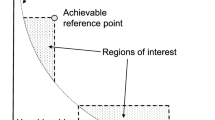Abstract
Hybrid interval multi-objective optimization problems are common in real-world applications. These problems involve both explicit and implicit objectives, and the values of these objectives are intervals. Few previous methods are suitable for them. An evolutionary algorithm with a large population and a user’s interval preferences was presented to effectively solve the problems in this paper. In the proposed algorithm, a similarity-based strategy was employed to estimate the interval values of implicit objectives of evolutionary individuals that the user had not evaluated in order to alleviate user fatigue; the user’s preferences to different objectives were expressed precisely as intervals by solving an auxiliary optimization problem; a sorting scheme based on the user’s preferences was proposed to guide the population evolving toward the user’s preferred regions. We applied the proposed method to an interior layout problem, which is a typical optimization problem with both interval parameters in the explicit objective and interval value of the implicit objective. The proposed algorithm was compared with four other optimization algorithms on the interior layout problem. Experimental results validated its effectiveness and superiority over the compared algorithms in terms of solution quality and the number of user’s evaluations.







Similar content being viewed by others
References
Funes P, Bonabeau E, Herve J, Morieux Y (2004) Interactive multi-participant tour allocation. In: Proceedings of IEEE congress on evolutionary computation, pp 1699–1705
Zhou Y, Gong DW, Zhang Y (2007) Evolutionary optimization methods for hybrid index optimization problem and application. Control Decis 22:352–356. doi:10.3321/j.issn:1001-0920.2007.03.025
Cheng ZQ, Dai LK, Sun YX (2004) Feasibility analysis for optimization of uncertain systems with interval parameters. Acta Autom Sin 30:455–459
Gong DW, Qin NN, Sun XY (2011) Evolutionary algorithms for optimization problems with uncertainties and hybrid indices. Inf Sci 181:4124–4138. doi:10.1016/j.ins.2011.05.011
Branke J, Deb K, Miettinen K, Slowinski R (2008) Multiobjective optimization - interactive and evolutionary approaches. Lecture Notes in Computer Science. Springer, Heidelberg, p 5252
Deb K, Pratap A, Agarwal S, Meyarivan T (2002) A fast and elitist multiobjective genetic algorithm: NSGA-II. IEEE Trans Evol Comput 6:182–197. doi:10.1109/4235.996017
Kamalian R, Takagi H, Agogino MA (2004) Optimized design of MEMS by evolutionary multi-objective optimization with interactive evolutionary computation. In: Proceedings of genetic and evolutionary computation conference, pp 1030–1041
Brintrup AM, Ramsden J, Tiwari A (2005) Integrated qualitativeness in design by multi-objective optimization and interactive evolutionary computation. In: Proceedings of IEEE congress on evolutionary computation, pp 2154–2160
Brintrup AM, Ramsden J, Tiwari A (2007) An interactive genetic algorithm-based framework for handling qualitative criteria in design optimization. Comput Ind 58:279–291. doi:10.1016/j.compind.2006.06.004
Limbourg P, Aponte DES (2005) An optimization algorithm for imprecise multi-objective problem functions. In: Proceedings of IEEE congress on evolutionary computation, pp 459–466
Li FY, Luo Z, Rong JH, Zhang N (2013) Interval multi-objective optimisation of structures using adaptive Kriging approximations. Comput Struct 119:68–84. doi:10.1016/j.compstruc.2012.12.028
Coello CAC (2000) Handling preferences in evolutionary multi-objective optimization: A survey. In: Proceeding of congress on evolutionary computation, pp 30–37
Parmee IC, Cvetkovic̀ D, Watson AH, Bonham CR (2000) Multiobjective satisfaction within an interactive evolutionary design environment. Evol Comput 8:197–222. doi:10.1162/106365600568176
Chaudhuri S, Deb K (2010) An interactive evolutionary multi-objective optimization and decision making procedure. Appl Soft Comput 10:495–511. doi:10.1016/j.asoc.2009.08.019
Deb K, Sinha A, Korhonen PJ, Wallenius J (2010) An interactive evolutionary multi-objective optimization method based on progressively approximated value functions. IEEE Trans Evol Comput 14:723–739. doi:10.1109/TEVC.2010.2064323
Sinha A, Korhonen P, Wallenius J, Deb K (2010) An interactive evolutionary multi-objective optimization method based on polyhedral cones. In: Proceedings of learning and intelligent optimization conference, pp 318–332
Horn J, Nafpliotis N, Goldberg DE (1994) A niched Pareto genetic algorithm for multiobjective optimization. In: Proceedings of the 1st IEEE congress on evolutionary computation, pp 82–87
Deb K, Kumar A (2007) Light beam search based multiobjective optimization using evolutionary algorithms. In: Proceedings of IEEE Congress on Evolutionary Computation, pp 2125– 2132
Greenwood GW, Hu X, D’Ambrosio JG (1996) Fitness functions for multiple objective optimization problems: combining preferences with Pareto rankings. In: Proceedings of 4th workshop on foundations of genetic algorithms, pp 437C455
Bentley PJ, Wakefeild JP (1998) Finding acceptable solutions in the Pareto-optimal range using multiobjective genetic algorithms. Soft computing in engineering design and manufacturing. Springer, London, pp 231–240
Wang ZJ, Li KW, Wang WZ (2009) An approach to multiattribute decision making with interval-valued intuitionistic fuzzy assessments and incomplete weights. Inf Sci 179:3026–3040. doi:10.1016/j.ins.2009.05.001
Gong DW, Qin NN, Sun XY (2010) Evolutionary algorithms for multi-objective optimization problems with interval parameters. In: Proceedings of 5th IEEE international conference on bio-inspired computing: theories and applications, pp 411–420
Gong DW, Yuan J, Ma XP (2008) Interactive genetic algorithms with large population size. In: Proceedings of IEEE congress on evolutionary computation, pp 1678–1685
Gong DW, Qin NN, Sun XY (2010) Novel evolutionary optimization algorithm for problems with hybrid indices. Control Theory Appl 27:769–774
Wilpon JG, Rabiner L (1985) A modified K-means clustering algorithm for use in isolated work recognition. IEEE Transactions on Acoustics. Speech, and Signal Processing 33:587–594. doi:10.1109/TASSP.1985.116458
Ishibuchi H, Tanaka H (1990) Multiobjective programming in optimization of the interval objective function. Eur J Oper Res 48:219–225. doi:10.1016/0377-2217(90)90375-L
Xu GL, Liu YJ (2008) A new ranking approach for interval numbers in uncertain multiple-attribute decision making problems. Stat Decis 19:154–157
Zitler E, Thiele L (1998) Multiobjective optimization using evolutionary algorithms - a comparative case study. In: Proceedings of 5th international conference on parallel problem solving from nature, pp 292–301
Acknowledgments
This work was jointly supported by National Natural Science Foundation of China with grant No. 61375067 and 61403155, National Basic Research Program of China (973 Program) with grant No. 2014CB046306-2, and Natural Science Foundation of Jiangsu Province with grant No. BK2012566. Thanks to Dr. Jianyong Sun for linguistic advice.
Author information
Authors and Affiliations
Corresponding author
Rights and permissions
About this article
Cite this article
Gong, D., Liu, Y., Ji, X. et al. Evolutionary algorithms with user’s preferences for solving hybrid interval multi-objective optimization problems. Appl Intell 43, 676–694 (2015). https://doi.org/10.1007/s10489-015-0658-x
Published:
Issue Date:
DOI: https://doi.org/10.1007/s10489-015-0658-x




